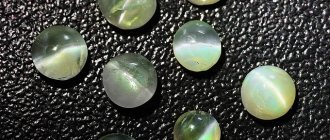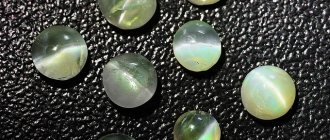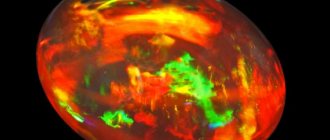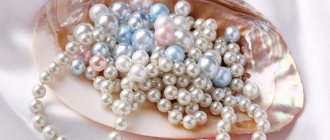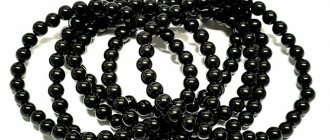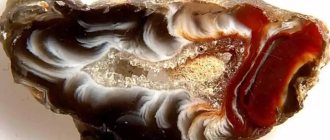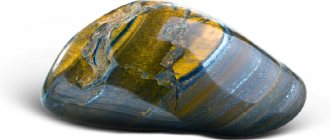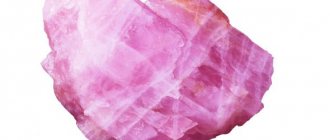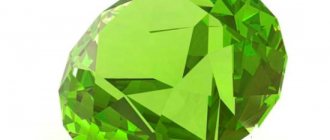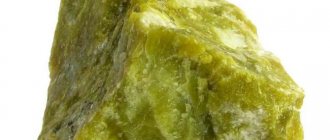Historical reference
Opal was known to ancient peoples; beautiful and frightening legends were created about it.
Opal is mentioned in myths and traditions on all continents.
- The ancient Greeks associated it with the victory of Zeus over the Titans, after which the supreme god burst into tears of happiness. The tears that fell to the ground became rainbow opals. It was believed that the Zeus stone made the owner a fortune teller.
- Australian aborigines are confident that sparkling stones, called “desert fire,” remained on the site of the traces of the Creator of the World.
- Arabic legends claim that opals are the children of lightning, brought to earth. The stone can protect from thunderstorms or bad weather, and make a person invisible.
- In India, opals are considered parts of the body of the rainbow goddess. Fleeing from annoying gentlemen, she fell, crumbling onto beautiful stones.
For centuries, opal's purpose has been to bring good luck. But the fall from grace is ambiguous. To the Romans it represented hope and purity, but black opal was Caligula's favorite. This friendship became fatal for the emperor. Scandinavian sagas say that the opal stone was forged by the blacksmith god from children's eyes. The early Middle Ages is full of descriptions of dark rituals with opal in the leading role. Opal powder was a poison that was added to food.
The English King Edward VII, in order to protect himself from the influence of the gem, ordered the opals to be removed from the crown. Napoleon's wife Josephine laughed at this - and in vain. When the Burning Troy pebble moved into their home, the couple divorced. Then they began to say that the mineral allegedly self-destructed, dissolving into the air. This is possible, given the properties of natural opal. Clients refused the stones, and jewelers had no choice but to throw them away.
Meaning of the word opal
Examples of the use of the word opal in literature.
In Volyn, Transcarpathia, Crimea and the Zhytomyr region there were not only granites and labradorites of various colors, but also jasper and marble, smoky quartz, golden and blue topaz, opal, amber and precious aquamarine and emerald.
Even if we assume that Arkady Ionovich’s chatter was true, that Barsky was in disgrace and Elder Nozhnitsyn did not value him a penny, then this could never have occurred to anyone in life.
If in this dispassion you, here, now, in front of you, suddenly saw Buckingham, Which of the two would at that moment be subjected to your disgrace: the handsome lord or the confessor?
The impact of the transparent emerald discharge was terrible: white canes scattered, black figures rolled out like knocked down pins, head capes flew out like bats, the figure of the grandmaster strangely flew up and strangely fell into a shapeless pile of clothes.
Listen to my story, the story of the disgrace suffered by a high-born half-breed - I, Morais Zogoibi, nicknamed the Moor, for most of my life the only male heir to the countless wealth acquired through the trade in spices and other goods of the da Gama-Zogoibi family from Cochin, excommunicated from everything for , as he believed, had the full and inalienable right, by the will of his own mother Aurora, née da Gama, an outstanding artist, the brightest of our masters of the present century and, at the same time, the sharpest-tongued woman in her generation, from whom anyone who approached her, he received a fair share of pepper.
John noticed these annoyances, or others who felt close to Vorontsov, for example, princes Mikhail and Yuri Glinsky, the sovereign’s uncles, pointed out to him another Shuisky in Vorontsov, only Vorontsov fell into disgrace along with his former enemies.
Meanwhile, on April 11, 1502, the Grand Duke put disgrace on his grandson, Grand Duke Dmitry, and his mother Elena and ordered their names to be thrown out of all government papers, commemorations, wills, prayers, litanies of some kind, and so on and so forth.
Could he stand firmly for the Godunovs, if at one time Boriska unjustly put him in disgrace together with the Romanovs and exiled him to the utter wilderness of Siberia - to Tobolsk, and, having forgiven him, still did not return the taken away Ryazan estate?
Mikhail Zenkevich, having miraculously escaped prison and exile, nevertheless did not escape the painful years of intense anticipation of reprisals, the sovereign's curse, surveillance, and secret disgrace.
Aulisse was attractive, but Meraklen was beautiful—the difference between a vulgar artificial gemstone and a cabochon of black opal.
When Kapitsa was in disgrace, Artyusha built a luxurious building for his Moscow laboratories at the end of the park, near the pond above the Moscow River.
The signalman ran to the boat, muffling the sound and grinding of the spare coil with his palms, returned to the major, threw the coil under the scree, fell to his knees, was about to plunge the ground electrode into the yielding ground, but the end of the wire turned out to be unstripped.
Filled with milk, it fell, turned purple and fell ingloriously, And the Celtic Yaroslavna cries into the distance from the dull rocks.
None of them even made a movement towards the hilts of the terrible swords, but Shchuk and Okultich instantly sank, and the giant Klaproth fell down, like an inflatable toy from which the air had been let out.
This appointment was not a disgrace, but in the context of the rapidly growing influence of the Fujiwara family on the imperial family, the need to live away from the capital could hardly please Tabito.
Source: Maxim Moshkov library
Origin
A fragment of the jaw of the ancient mammal Kollikodon ritchiei, which became opal during the process of fossilization. It
has been scientifically proven that opals are petrified trees and skeletons of small animals. They formed in the ground or craters of volcanoes.
Forms of opal release: cluster-shaped or kidney-shaped aggregates of amorphous silica, cracks. It usually occurs among limonites, sandstones, rhyolites and basalts.
The origin is sedimentary, supergene or low-temperature hydrothermal. It occurs in the form of veins, filling cracks in the host rocks.
The rocks diatomite, tripolite and opoka are made up of scattered small particles of opal.
Opal forms various kinds of sintered forms or nodules, often forms pseudomorphs on various minerals, and also impregnates various animal and plant remains, forming fossils. Sometimes found in the form of earthy masses or fine powder.
How is opal formed?
Opal is formed from a solution of silicon dioxide and water. When water seeps through sandstone, it picks up tiny particles of silica. Millions of years ago, solution flowed into cracks and voids in sedimentary as well as volcanic areas in Australia. Estimates indicate that this solution had a sedimentation rate of approximately one centimeter every five million years at a depth of 40 meters. Over a period of approximately 1 - 2 million years after this period, as the climate changed, solidification occurred. Thus, the opal remained soft and without cementation for a long period of time before becoming fossilized.
Physical and chemical properties
Opal is amorphous silica, devoid of a crystal lattice. Semi-precious jewelry stone.
The color of opal varies, but all types have a common characteristic: pearlescent luster. The effect in which the glow comes from inside the stone and scatters across the surface is named after the stone - opalescence. Applies to other precious minerals.
Opals can be transparent or translucent. This determines the percentage of water in the stone: the more, the more transparent the gem. For the noble ones - strictly 6-10%.
| Color | Colorless, white, yellow, red, brown, blue |
| Stroke color | white |
| origin of name | from the ancient Indian upala - precious stone |
| Opening year | known since ancient times |
| IMA status | valid, first described before 1959 (before IMA) |
| Chemical formula | SiO2+H2O |
| Shine | glassy, greasy, waxy, pearlescent, dull |
| Transparency | transparent, translucent, opaque |
| Cleavage | not visible |
| Kink | conchoidal, uneven |
| Hardness | 5,5, 6, 6,5 |
| Thermal properties | Under the blowpipe it cracks a lot, but does not melt. |
| Luminescence | yellow-green (uranyl) |
| Strunz (8th edition) | 4/D.01-80 |
| Hey's CIM Ref. | 7.8.8 |
| Dana (8th edition) | 75.2.1.1 |
| Molecular weight | 87.11 |
| Density (measured) | 1.9 — 2.3 |
| Pleochroism | does not pleochroate |
| Refractive indices | nα = 1.400 – 1.460 |
| Optical relief | moderate |
| Selection form | kidney-shaped, collomorphic cluster-shaped, stalactite sinter aggregates, plaques, concretions, geodes, solid masses, pseudomorphs of organic remains and some minerals |
| Classes on taxonomy of the USSR | Oxides |
| IMA classes | Oxides |
| singonia | amorphous |
| Fragility | Yes |
Colors and varieties
Depending on the properties: color, shine, transparency, hardness, impurities, a fairly significant number of varieties of opals are distinguished.
Opals formed from the silica of weathering silicate rocks, filling cracks and voids in them or penetrating into their mass, are “impure.” These include:
- semi-opal, cloudy, with a greasy sheen, white, gray, yellow, red and brown;
- opal jasper, which is colored red or brown with an admixture of a significant amount of iron oxides.
Opal Jasper
- Wood opal – formed when opal replaces wood residues, preserving the texture of wood (petrified wood).
Wood opal
- Siliceous tuff is a porous, spongy rock formed from hot springs.
Siliceous tuff
- Tripoli (polishing slate) are earthy, loose deposits of microscopic organisms, mainly diatoms.
Trepel
- Noble opal is distinguished by a beautiful play of colors. The color is mostly milky white or yellowish, blue and even black. Translucent or translucent. Refers to precious stones.
Precious opal
- Ordinary opal does not have a play of colors. Transparency to varying degrees. Sometimes colorless, but mostly painted in various dim colors. Beautiful specimens are polished and considered semi-precious stones.
Common opal Other types of opals:
- Fire Opal - Translucent to translucent stones, mostly with colors ranging from hyacinth red to wine yellow, almost red, often without any play. Variations with opalescence are mined in Mexico.
Fire opal
- Black opal is an opal with a dark, not necessarily black, base color, the most expensive variety of precious opals (in particular, Australian black opals).
Black opal
- Boulder (English boulder - cobblestone, boulder) is a type of opal in the form of a layer in the rock, most often ferruginous, but there are also matrix boulders in rhyolite and basalt rocks. The best varieties of boulders, jowa and koroite, are mined in Australia.
Boulder opal
- Wax opal is waxy yellow in color.
Wax opal
- Hyalite is water-transparent, forms grape-shaped crusts on various rocks; sometimes covered with mosses and lichens.
Opal Hyalite
- Hydrophane, water opal, is porous; when saturated with water, it becomes translucent and reveals a beautiful play of colors.
Hydrophane water opal
- Girazol (girasol, girasol) is transparent, almost colorless, with an iridescent bluish tint, usually on a pale milky background.
Opal Girasol
- Irisopal is colorless or slightly brownish with a single-color tint, mined in Mexico.
Irisopal
- Cacholong, pearl opal, semi-opal is a milky white stone that is an opaque mixture of quartz, chalcedony and porcelain opal.
Cacholong
- Peruvian (blue) opal - pink, blue and even bluish stones are found in Peru. They are not multi-colored.
Blue Peruvian opal
- Prazopal, chrysopal is an opaque apple-green stone.
Chrysopal
What is OPAL?
Opal is one of the most beautiful gemstones in the world and is widely used in jewelry. It is one of six types of precious minerals found on planet Earth, sharing prestigious company with diamonds, rubies, sapphires, emeralds and pearls.
Opal is Australia's national gemstone, where more than 95% of the world's precious opal comes from.
Scientifically, opal is known as a mineraloid, amorphous silica SiO2·nH2O (silicon dioxide hydrate, that is, a mixture of silica and water). The color of opal can vary from colorless, white and light gray (hyalite, or milky opal) to dark gray and black. The variety of darker colors (blue, rich green, bright red, brown, amber yellow) is due to impurities - oxides CaO, MgO, Al2O3, Fe2O3, FeO, Na2O, K2O. However, the real uniqueness of opal is that it displays all the colors of the spectrum in a "play of color" - an iridescent play of colors, opalescence resulting from the interference and diffraction of light passing through tiny spheres of silica in the microstructure of the opal. This means that the opal's vibrant iridescent colors as they appear to the human eye will move and change dramatically depending on the viewing angle of the stone. These types of opals are referred to as “precious opals”.
Although there are several different types of opal found in nature, there are two main varieties: gem opal and common or pot opal. Precious opals exhibit a characteristic play of color and are relatively rare. The common name for opal is that it is dull and colorless. Common opal is found in abundance throughout the world. When common opal is found in combination with precious opal, it is called potch. Common opal and sweat do not show color play. About 95% of all opals mined from opal fields are common or flow opals, that is, opals that exhibit primarily one color, i.e. white, grey, black, and are used as spacers for doublets or triplets. Of the 5% that has some color, about 95% is only middle class, so only about 0.25% has any real value.
Place of Birth
Opal
Opal is often found in thin layers or flat lenses, large pieces are rare. It is found on all continents, but Australian deposits account for, according to some statements, about 97% of all world production. Of these, 90% are called “light opals” or white crystalline opals.
Most Australian opals are mined in Coober Pedy in South Australia. The boulder type is mined in the state of Queensland. One of the largest mines producing this type of mining is Jundah. In the state of New South Wales, in the area of the town of Lightning Ridge, another opal with a predominant black color is mined (with a play of colors from dark gray to black-blue). This type is considered the rarest, as black opal accounts for only about 5% of the total opal mined in Australia. Opal is considered the national stone of Australia.
In addition to Australia, Ethiopia is a major exporter of opals. Most of the precious opals are mined in Australia, Mexico, Brazil, Guatemala, Honduras, Japan, Slovakia, the USA (Nevada), with minor occurrences in Russia (Kamchatka) and Ukraine.
Ordinary and fire opals are often found in Mexico (states of Hidalgo (state) and Queretaro), Brazil, Guatemala, Honduras, USA, Turkey, Kazakhstan.
This is interesting!
In late 2008, NASA announced that it had discovered opals on Mars.
Magical properties of opal
Black opal ring
The magical qualities of opal have been studied by magicians and esotericists. But the influence of the stone is ambiguous; caution is required with it.
The energy of the opal will excite the owner. For active, mercantile pragmatists who live in a strict rhythm, this is a suitable option. People leading a leisurely or measured lifestyle will be “crushed” by the stone. Opal is endowed with strong energy, but it “agrees” to serve only charismatic, talented owners. The rest will be alienated or made unhappy.
In natures with an unstable character, the gem will give rise to suspiciousness, quarrelsomeness or fear.
Creative people understand the meaning of the stone: opal activates and directs the creative process, preventing outside influence.
The magical properties of natural opal are determined by its appearance and color:
- Black. An attribute of sorcerers, strong personalities or passionate natures. Sharpens the mind and analytical thinking. But the magic of opal, especially in gold, activates vices, which is advisable for future owners to take into account. First of all, players and adventurers.
- White. Stone of virtue, talisman of philanthropists, healers, social workers. Supports patience and compassion.
- Fiery. The magical properties of this stone enhance gender traits: in men - confidence, in ladies - femininity and wisdom.
- Blue. Opals ranging from blue to ultramarine bring good luck. Ideal amulets on the way to the goal, helping to gather strength, directing them in the right direction. The stone makes the owner clairvoyant (especially in a dark purple hue). It will remove tension during communication or add confidence.
- Pink. Suitable for people seeking peace or security. Harmonizes the inner mood and love sphere, protects against illnesses or failures. Relieves stress, insomnia or nightmares.
Amulets and talismans with opal
Opals have long been used as talismans; ancient people believed that this stone was able to preserve the family hearth and protect its owner from harm. The pendant has strong magical properties and is more suitable for charismatic people. In addition, it is believed that the stone helps develop creative abilities in gifted people.
It is believed that the conductor is able to protect against the effects of negative energy. Other magical properties of this gemstone include:
- Ability to enhance analytical abilities and increase passion in love relationships. This applies to black colored stones.
- White stones are more suitable for quiet and calm people leading a measured lifestyle.
- Stones with a fiery hue bestow masculinity, strength and wisdom when making decisions.
- Blue stones are intended for those who are trying to catch luck by the tail.
With the help of the stone, it is possible to preserve and accumulate energy; wise people consider the gem unique due to its ability to help those who have set big goals.
Medicinal properties
Opal Girazol ring
Opals can be worn not only as decoration, but also to provide a healing effect on the body.
Lithotherapists claim that opal:
- Increases stress resistance.
- Normalizes the functioning of the nervous system.
- Improves mood, regulates mental activity.
- Improves the functioning of the central nervous system.
- Raises muscle tone, relieves nervous tics, softens the manifestations of chronic cramps.
- Normalizes the activity of the heart muscle, helping to restore the correct heart rhythm.
- Improves the general condition of the eyeballs and vision by normalizing blood flow in the vessels of the eyes.
- Promotes the digestion of food by normalizing gastric peristalsis and increasing blood flow in the collateral perigastric vessels.
- Useful for women because it can facilitate childbirth and limit the growth of body hair.
- Dissolves toxins, cleansing the body.
- Eliminates pain (toothache and headache).
- Helps improve appetite.
- Has a beneficial effect on the kidneys.
- Improves sleep.
- Grants longevity.
Talismans and amulets
Gold ring with white opal
Gold ring with white opal, worn on the index finger of the right hand, is a talisman for people involved in medicine, since this stone gives them the ability to heal the sick, alleviating their suffering.
An opal amulet will ensure success in business if the owner overcomes selfishness or greed.
Taking such a talisman with you on a long trip or on a tourist trip, you can be sure that your exhausted strength will quickly be restored.
A pendant or keychain in silver is a lifeline for melancholic people, suicidal people, and people hovering in a fantasy world. Opal amulets and talismans (figurines, boxes, simply processed stones) will maintain peace in the house and protect the home from natural disasters or robbers.
The natural energy of opal reaches peak values by October.
“To be in disgrace” - what does the expression mean?
In household use, the word “opal” comes from the words “scorch”, “scorch”, that is, “to burn”. Under the influence of fire, they cleaned animal skins of bristles or birds of feathers.
You will be interested in: “Darlings scold - they only amuse themselves”: the meaning of the expression and the psychology of relationships
Starting from the 15th century, the figurative meaning of the word entered the Russian language: “to fall into disgrace” or “to be in disgrace” began to mean “to be in disgrace, to lose previous privileges.”
The term “to be in disgrace” had broad legal consequences for the holder of power who had fallen out of favor: from removal and prohibition from appearing at court to deprivation of property, ranks, awards and titles.
In addition to confiscation measures, the expressions “to be in disgrace”, “he is in disgrace” often meant exile and even the death penalty.
Disgrace should be distinguished from punishment under the law of the person who committed the crime. This distinguishes disgrace from procedural punishments. Anyone can be subjected to disgrace and persecution, regardless of whether he committed a crime or not.
Disgrace is usually caused by anger, deep hostility or other considerations of a high-ranking person towards the disgraced person. Thus, the background to “disgrace” is the moral, moral, ethnic or political reasons for its occurrence in a person’s fate.
In the lives of many bright personalities, such a fateful period began as being in disgrace. Boyarina Morozova, for example, fell into disgrace in the 17th century. This period is depicted in the painting by V. Surikov: the disgraced noblewoman is taken to the monastery on the sledge, she raised two fingers as a sign of her belonging to the old faith, not accepting church reforms. Because of this, she found herself in disgrace.
She was exiled first to the Chudov Monastery, deprived of her wealth and lands, then to the Pskov-Pechora Monastery. The noblewoman ended her life in the Borovsky prison. Neither torture nor deprivation broke the disgraced noblewoman - she did not renounce the old rituals.
Areas of application
Wax opal
Tripel ring was previously used as a material for making dynamite.
Noble opal belongs to precious stones; the best examples are highly valued. The largest opal found near Coober Pedy in 1956 is valued at A$2.5 million. To better display the color play of precious opals, they are given round or oval cabochon shapes or other softly convex shapes, depending on how the raw material allows it.
Mass-produced jewelry often uses opal doublets—polished opal flakes glued to onyx, obsidian, black glass, or regular opal.
If opals are stored in low humidity conditions, loss of moisture may cause them to crack and become cloudy. Therefore, jewelry and jewelry with opals should be worn as often as possible, since the gemstone can take the moisture it needs from the air or the skin of the person who wears it.
Due to the low hardness of opal, when creating jewelry, craftsmen make frames that protect them. Previously, the surface of the opal was covered with oil, then they switched to impregnating the opals with colorless artificial resin.
Currently, synthetic opals are widely produced, including in Russia (in St. Petersburg and Novosibirsk). Imitations and counterfeits of opal are common, mainly when they pass off specially made opalescent glass as it.
The rocks consisting of opal, diatomite, tripolite and opoka, are raw materials for cement, fillers and other building materials.
This is interesting!
The ancient Romans considered opal a stone that brought good luck. In many countries, it is still perceived today as a talisman. In 1829, Walter Scott published the novel Anna von Geyerstein, in which opal brings death to its owner. After the novel was published, the demand for opals fell by half and remained low for the next 20 years. In Russia, the myth of opal as a stone that brings misfortune was perpetuated by I. V. Kireyevsky’s story “Opal” (1830). Opal is the official stone of South Australia and the Australian women's national basketball team, The Opals.
Common Peruvian opals
Opals from Peru
Opals from South America, Peru, are identical in composition to quartz, but have a pastel green color. Peruvian opals are found in the Andes mountains. It is believed that they have a healing and rejuvenating effect on humans. These stones are hard, mostly green, but also pink. Peruvian opals are relatively rare and are found only in the Andes Mountains, near San Patricio in Peru. It is a very translucent stone with a color very reminiscent of the Caribbean Sea. Depending on how the opal was carved, it can be clear, scenic, or dendritic, reminiscent of trees or moss. The Andes are famous for their pink and blue opals. You won't find the colors of Australian opal in them, but there is a lot of pink and blue. This is the national stone of Peru.
Products and jewelry made of opal
Jewelry set with opal
It is believed that the shade of the stone should be selected according to the color of the eyes. At the same time, white and black representatives are suitable for all people, regardless of their appearance. Therefore, they are the most in demand.
Silver and gold are used for the frame. It is believed that black minerals cannot be included in a gold frame, as this will make them aggressive towards their wearer. Therefore, they can most often be seen in silver. Gold is often used for green, blue, cyan and yellow stones.
How much an opal costs depends on many characteristics: color, inclusions, size, rarity of the specimen, color play. The price per carat can start from $10 and go up to $5000–6000. A magic stone is not suitable for everyone; if you have doubts about purchasing it, it is better to stick to light-colored gems. And before buying, you should feel the energy of the mineral, hold it in your palms for a few minutes to understand your own sensations.
Opal: legends and myths
There are many of them among different nations.
Australia, rich in opals, believes that gems are traces of the Creator of the World.
In India they will tell you a myth about a woman who was running away from being pursued by a man. She ran away, tripped, fell... No, she didn’t lose consciousness. But when it fell, amazingly beautiful stones scattered from it.
Ancient Greek tale. When Zeus and his sisters and brothers pushed their daddy Kronos off the throne (there was a reason), Zeus burst into tears of happiness. Tears fell to the ground and turned into rainbow stones.
Consultations with historians did not confirm this version. There is no myth about opal and the tears of Zeus.
But there is this ancient Greek myth: Kronos was predicted that he would be overthrown by his own children. So he decided that the appropriate solution would be to swallow the kids. The Stone of Zeus, according to one myth, is the same stone that Kronos swallowed instead of the newborn Zeus. And Rhea’s wife slipped the stone into the diapers (Oops, Ops). The poor goddess is tired of giving birth to children and giving them to her heartless husband to feed.
I recommend watching the video about the secrets of opal.
Why opal?
It is generally accepted that the name may have come from "upala" (Sanskrit) - stone.
“ Enchanting sight ” - this is how the name of the gem is translated from Latin.
Pliny the Elder believed that the name is related to Ops - the goddess of fertility, the wife of Saturn (among the Greeks Kronos), the ancient Roman god of agriculture. God was stern and often ate his children. Some of the Saturnalia (festivals in honor of Saturn) were dedicated to Ops and were called “Opalia”.
Informative: some rituals from the Saturnalia are repeated in Christian Christmastide.
The Indians, with their ardent love for stones, were the first to notice opal. From India the gem came to Europe.
Interesting: NASA reported in 2008 that opals had been found on Mars.
Synthetic opal
Synthetic opal
Artificial opals can be distinguished as a separate type, the production of which has been constantly growing since the beginning of the 20th century. The main types of synthetic stones are:
- Gilson opal was first obtained in 1972 in Switzerland. This is the most expensive artificial type of stone, which is most similar to natural gems, but is distinguished by the complete absence of water and high stability of the material. The formation process of Gilson stones lasts about 18 months.
- Japanese Kyocera opal , obtained on the basis of hydrated silicon oxide, is distinguished by its high aesthetic qualities, therefore the composition of the artificial stone is identical to natural samples. To increase the density and stability of the rock, samples are impregnated with colorless rubber.
- Slocum opal created in 1964 , which is an alloy of sodium-enriched silicon glass and aluminum sparkles that create an iridescent effect.
- In Japan, a plastic imitation has been developed - neo-opal , or pastoral opal.
- In the USA, the production of milky blue opalite - a plastic imitation made of polystyrene, which is coated with acrylic resin, creating the effect of a play of colors inherent in opals. Sometimes samples obtained synthetically are passed off as moonstone.
How to spot a fake
Pendant with opal stone
Natural opal can be very expensive, especially if it is a noble variety. Fraudsters have invented several ways to counterfeit precious varieties of gems:
- The simplest and cheapest is to imitate a mineral using plastic or glass.
- Selling cheap varieties under the guise of expensive ones. For example, resin stone is passed off as an elite “night stone”.
- Doublets and triplets. A thin plate of a noble variety is glued with one or two plates of an ornamental variety.
- Artificial stones. They tried to grow crystals in the laboratory back in the 19th century. The breakthrough came in 1972. It was then that chemically produced Gilson opals entered the market.
It should be remembered that a plastic fake, like a synthetic opal, does not have the magical and healing properties of the original. Fortunately, it is quite easy to distinguish a fake if you remember the basic properties of the gem.
First of all, you need to pay attention to what the opal stone you are going to buy looks like. A genuine gem is distinguished by “floating” lights. If you look at it from a different angle, they will change their position in the thickness of the crystal. In a laboratory mineral, the sparks are always motionless.
The price of opal can also say a lot. Jewelry with a night or fire gem is unlikely to cost less than a thousand rubles. These are very rare varieties of the mineral, and jewelers and miners value their work quite highly.
What will the king say?
At the beginning of the reign of Paul the First, the great Russian commander A.V. Suvorov fell into disgrace with the Tsar. He did not recognize the innovations in the Russian army imposed by the emperor, especially the imitation of Prussian models of military art. They say that Suvorov publicly spoke quite harshly against the Tsar:
Powder is not gunpowder, letters are not cannons, a scythe is not a cleaver: I am not a German, but a natural hare!
These and other similar puns, brought to the attention of the emperor, completely angered him: Suvorov’s authority to command the troops was removed, he fell into disgrace, and was sent into exile in a remote village.
It seems that the great commander in L. Vashli’s painting “Suvorov in Disgrace” knows that his story is not over yet, and soon he will be called to serve his Motherland by the sounds of a military horn. So it will be.
How to care for stone
Opal is a fragile stone. It needs special care and careful handling. In order for the mineral to retain its beautiful appearance for a long time, follow certain rules:
- Do not allow chemicals or cosmetics to come into contact with the mineral.
- Keep away from moisture (water opal is an exception).
- Remove jewelry before physical activity.
- Clean when dirty with soft brushes or a cloth in soapy water.
- Rinse from time to time from negative energy under running water. After drying, put it to charge with moonlight.
Compatibility with other minerals
Jewelry with blue opal
When choosing jewelry with natural stones, you should consider their compatibility, since a natural gem carries certain information that may resonate with the background of other stones. In this case, the owner will experience discomfort.
Contradictions between minerals can provoke sudden mood swings, uncertainty in decision-making and one’s own strengths.
Opals are stones of the water element, so they go well with minerals of the Earth element, and fire and air gems should be worn separately.
The best companions for opals are amethysts, turquoise, lapis lazuli, blue sapphires, onyx, white pearls and labradorite.
You should avoid sets in which opal is combined with agates, garnets, heliotrope, ruby, carnelian, malachite, chalcedony or jasper.
Opal and zodiac signs
Opal in jewelry
Representatives of fire zodiac signs should acquire white or blue opals. These universal stones are suitable for people born under any zodiac constellation, but for Sagittarius , Leo and Aries they will help smooth out the manifestations of natural deficiencies, enhancing their best qualities, represented by courage, determination and determination.
At the same time, according to the horoscope, Aries should beware of stones that have dark shades, and Sagittarius should prefer blue opals.
Both fire and white gems are suitable for Gemini, Aquarius and Libra White stones will give them calmness, and the shimmer of fiery specimens will add a bit of violence to their character. Aquarians may like dark blue minerals.
For Pisces and Scorpios, stones of blue-blue and red colors will be useful. Their influence will not only strengthen Pisces’ innate intuition, but will also give them peace of mind. Scorpios, who have received protection from negative influences, will be able to concentrate their energy on achieving their goal.
For Cancer, there is nothing better than white opals, although this is the only zodiac sign that is allowed to wear black stones. By enlisting their support, Cancers will be able to overcome their inner experiences and fears, find harmony in personal relationships and improve their financial condition.
Taurus should pay attention to blue gems: they will give their owners patience and tranquility.
Fire opal is ideal for Virgo and Capricorn By saving Virgos from excessive criticality, he will make them much kinder. With its help, Capricorns will get rid of the habit of groundless worries.
The mystery of opal: interesting facts and magical properties
Who was the first in history to introduce the trend for opals, why white stones are considered the most “peaceful”, and what magical effects they have - about this and much more - in the article below.
Reference
Name: opal - from Sanskrit. the words उपल [upalaḥ] - translated as “precious stone”.
Hardness on the Mohs scale: 5-6.5
Color: various (more than 100 options)
Main types
White opals are translucent in color with a light blue shimmer.
Black opals - these also include stones of purple, blue, green and burgundy shades; with a multi-colored glow, red flashes are often observed.
“Harlequin” is the name of an opal with a multi-colored pattern that shimmers in different colors.
“Fire” opals are yellow and red stones.
“Hydrofan” is a white stone, in the color of which you can distinguish other shades. When placed in water, it becomes transparent and begins to shimmer. “Lechos-opal” is a green opal that shimmers with greenish and burgundy reflections.
“Cacholong” is an opaque milky-white opal.
“Girazol” is the name of blue, colorless opals with shimmer in reddish tones.
“Royal” opals are called stones with an unusual color: inside they are dark red or bronze, the border is bright green.
“Peruvian” opals are orange and bluish-green opals.
Prazopal is an apple-green stone.
“Irisopal” is the name of a colorless or brownish opal with a single-color shimmer.
Interesting facts about opal
- The ancient Romans called this stone of magical beauty nothing less than “enchanting sight” (opalus); “striking the eye” (ὀπάλλιος) - ancient Greeks. The secret of opal lies in the incredible optical effect - opalescence: when exposed to bright lighting, the stone begins to glow with pearlescent rainbow colored tints or “spots”.
- It was the unearthly beauty of the stone that in ancient times became the reason for the persecution of the Roman senator Nonius, who possessed the largest such nugget in the world. Because of such a treasure, Emperor Anthony himself became jealous of the senator, who ordered him to be expelled from his homeland. Nonius went on the run, but fell from grace, according to sources, and was saved and preserved.
- The structure of opal is of particular interest to researchers - it can contain up to 20% water!
- The best examples of these amazing stones, found in Australia - the country where the main deposits are located - are estimated at more than $10,000 per... carat!
- And the next fact is for those who would like to show off not only luxurious jewelry with opals from the new SOKOLOV Cruise collection, but also the title of an expert on curious cases from history. Queen Victoria of England at one time became the savior of the rare opal stone, launching perhaps the first jewelry “PR campaign”! The fact is that in ancient times opal was attributed with various magical properties, and by the 19th century things reached the point where they simply began to “fear” the stone. A lot of antiques and family household items inlaid with opals were simply thrown away as “unnecessary”: the reason for this was various superstitions associated with these beautiful stones. At the same time, in Australia, where the British colony was then located, the world's largest deposits of the mineral had just begun to be explored. It was necessary to somehow “advertise” the precious stones, so that every fashionista would want to have jewelry, without remembering the former bad glory of opal. Queen Victoria found a way out: she became a trendsetter by simply starting to bring opal necklaces, rings and earrings to high society. The ladies of the court, and then the commoners, began to fuss: everyone wanted jewelry, like the queen herself!
Magic properties
- Zodiac Synergy: Opal is ideal for people born under the sign of Pisces. Of course, having felt a “special” warmth towards the stone, almost every person can make it their talisman.
- Properties of the amulet: since ancient times, opal has been used as an “antidote”, capable of resisting dark magic, witchcraft damage, the evil eye and natural disasters. To this day, knowledgeable people claim that the unusual mineral protects its owner from thieves, fires, lightning during thunderstorms and other accidents.
- Love talisman: in eastern countries, opal was worn as an amulet to guard love and family happiness.
- Color influence: black opal “favors” only Scorpios; the pebble does not have the best effect on other representatives of the zodiac circle: some develop a fear of the dark, while others develop a craving for deception, temptations and enticements of various kinds. White opals, on the contrary, are considered “peaceful” stones: they give harmony in the soul to a restless person; for those who do not understand people - insight and intuition, and also help to develop natural talents and understand their purpose.
- Multiplying effect: opals set in gold double their magical effect, but wearing such jewelry every day is not recommended - choose silver as a frame for everyday wear.
- Healing properties: according to lithotherapists, opal helps treat nervous diseases, helps eliminate depression and insomnia, and the consequences of stressful situations. The ancients believed that the magic stone helped prevent heart disease, fainting, and also saved from despondency. In addition, they say that looking at the unusual iridescence on the surface of a stone should not only be for pleasure, but also to maintain healthy vision. Believe it or not - it’s up to you, but we know for sure that the “appearance” of the opal will attract not a single admiring glance in your direction!
- Law of attraction: opal accumulates both positive and negative energy, so only conscientious and honest people should choose it as a talisman; For those who are accustomed to “darkening” the stone, according to ancient beliefs, various misfortunes are promised. If opal becomes the amulet of a kind, selfless person, he begins to have luck in literally everything, no matter what he undertakes.
- The property of “transformation”: surprisingly, opals suit women of a wide variety of color types. This is one of the few stones that, when tried on, “fits perfectly” on blondes, brunettes, and redheads. The fact is that, thanks to the optical illusion mentioned above, which causes multi-colored tints on its surface, the stone seems to “adjust” to any skin tone and eye shade, emphasizing the advantages of its owner’s appearance.
Which opal jewelry would you choose as your talisman and why? Share your opinion in the comments!
Favorable time to buy
Ring with white opal stone
Opal is a stone that requires special attention. In order for the mineral to show its magical and healing powers in full, when purchasing jewelry, you need to follow some recommendations:
- It is better to buy white opals on the 4th lunar day of the calendar. It is worth giving the minerals 2 weeks to get used to the energy of the owner and start wearing them after the period has passed.
- You should buy milk stone on the 14th day of the lunar calendar, and start wearing it on the 28th.
- The purchase of fire opal should be planned for the 25th lunar day, and worn from the 11th day of the next month.
- Buy the rest of the gems on the 15th lunar day, wear them from the 29th–30th day.
Rainbow Stone Astrology
Astrology considers opal to be the birthstone of October.
The patron planet is the Moon, some astrologers are sure that different types of opals are also ruled by Neptune and Pluto.
We recommend: LEUCOSAPPHIRE - the modest charm of a gem
Many astromineralogists are sure that opal is suitable for any zodiac sign. It is important to choose the right type of stone.
- Red and fire opal are suitable for fire signs. This is especially true for Aries and Leo.
- Pisces is ideally compatible with transparent opals.
- Scorpios - your stone is black opal.
- Cancers and Libras can benefit from wearing precious jewelry.
- According to the horoscope, green and black opals are suitable for Taurus and Capricorn.
Recommendation from astromineralogists: wear a ring with an opal on your middle finger, and during the day put the stone on the middle finger of your left hand, then on your right, 2-3 times.
Interesting facts about the stone
- The largest (weighing 5280 g and measuring 12x23 cm) black opal was found in Australia in 1990.
- Eight years later, an opal weighing 4,300 grams (equivalent to 21,500 carats) was discovered in Brazil by two farm laborers working in a corn field. The cost of this stone was 60 thousand dollars.
- An interesting find, represented by a completely opalized skeleton of a small (not exceeding 15 cm) reptile, was made in 1909 in one of the Australian mines. Each part of the skeleton, replaced by opals endowed with unique color tints, was extremely well preserved. The curiosity, called the “opal snake,” was immediately acquired for a private collection.
